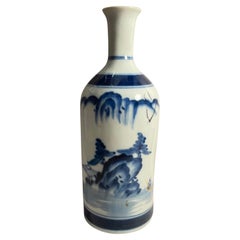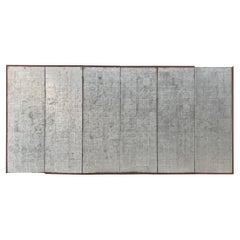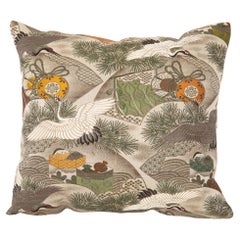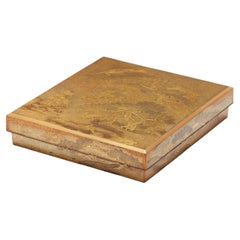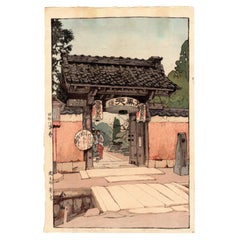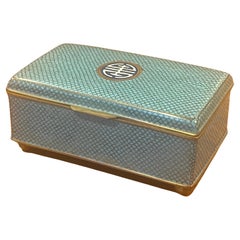Japanese Furniture
to
1,938
4,828
3,331
9,388
915
184
650
335
97
65
49
38
31
30
25
15
11
7
4
3
2
2
1
591
3,423
5,374
1,099
1,691
1,665
941
183
51
136
118
77
292
384
283
271
93
3,526
3,348
2,479
2,274
1,489
14,007
569,623
167,761
165,557
137,664
10,487
10,318
10,363
90
43
43
42
42
Place of Origin: Japanese
Japanese Antique Sake Bottle 'Landscape' 1920s Taisho era
Located in Paris, FR
This is a Sake bottle made in Japan around 1920s. These kind of bottles are called Kayoi tokkuri. On this bottle, there are a drawing of a Japanese view.
It can be used as serving sa...
Category
1920s Taisho Vintage Japanese Furniture
Materials
Ceramic
Meiji Period Silver Oxidized Screen
Located in Fukuoka, JP
Meiji Period Silver Oxidized Screen
Period: Meiji
Size: 352 x 174 cm
SKU: 2424
Step back in time with this Meiji period screen, where the allure of silver oxidation artfully c...
Category
Late 19th Century Meiji Antique Japanese Furniture
Materials
Silver Leaf
Pillow Cover Made from a Vintage Obi, Japan
Located in Istanbul, TR
It does not come with an insert.
Linen in the back.
Zipper Closure.
Dry Cleaning is reccommended.
Category
Mid-19th Century Antique Japanese Furniture
Materials
Metallic Thread
Antique Japanese Ink Stone Maki-e Lacquer Box Suzuribako Edo Provenance
Located in Atlanta, GA
A Japanese ink stone box (known as Suzuribako) with exquisite maki-e decoration from Edo period (circa mid-18th century). The box features a rectang...
Category
18th Century Edo Antique Japanese Furniture
Materials
Wood, Lacquer
Hiroshi Yoshida, “a Little Temple Gate”., Woodblock Print
Located in Norton, MA
A wonderful woodblock print image titled "A Little Temple Gate" by one of Japan's finest 20th-century artists and one of, if not the greatest working artis...
Category
Early 20th Century Japanese Furniture
Materials
Paper
Japanese Cloisonne Lidded Trinket Box with Bun Feet from the Meiji Period
Located in San Diego, CA
An exquisite Japanese cloisonne lidded box with brass bun feet from the Meiji period, circa late 1800's. The box has a great inticate geometric de...
Category
Late 19th Century Meiji Antique Japanese Furniture
Materials
Brass, Enamel
$960 Sale Price
20% Off
Original Vintage Travel Poster Skiing Hot Springs Japan Shima Onsen Tobu Train
Located in London, GB
Original vintage winter train travel poster promoting skiing and hot springs in Shima Onsen by Tobu Railways featuring a great graphic design depicting a smiling skier wearing a yell...
Category
1950s Vintage Japanese Furniture
Materials
Paper
Japanese Large Red Silk Brocade Gilded Two Panel Folding Screen
Located in Takarazuka, JP
Exquisite contemporary Japanese two panel folding screen or "byobu" featuring genryoku style handcrafted silk raised kimono in cream and gold needlework on a mesmerizing red background. Tagasode is the way a genryoku kosode kimono is hung over a kimono rack...
Category
21st Century and Contemporary Japanese Furniture
Materials
Gold
The Empire Strikes Back 1980 Australian Daybill Film Poster, Ohrai, Star Wars
Located in Bath, Somerset
Extremely rare first-year-of-release Australian Daybill film poster for The Empire Strikes Back. Arguably the best film of the Star Wars franchise, Nori...
Category
20th Century Japanese Furniture
Materials
Linen, Paper
Paul Jacoulet Signed Japanese Woodblock Print Marionettes Chinoises Chinois 1935
By Paul Jacoulet
Located in Studio City, CA
A fantastic original woodblock print by famed French artist Paul Jacoulet titled "Marionettes Chinoises Chinois. (Chinese Puppets. Chinese)" Jacoulet was famed for his techniques inv...
Category
1930s Showa Vintage Japanese Furniture
Materials
Paper
Japanese Antique Low Table, Wabi Sabi
Located in Katori-Shi, 12
This is an antique wooden low table from the Meiji period (1986-1912).
The curved legs are beautiful.
It was used as a workbench by craftsmen at the time.
The material is high-qual...
Category
Early 20th Century Meiji Japanese Furniture
Materials
Wood
Japanese bamboo sculpture of a seated toad realised in the rhizome
Located in PARIS, FR
Bamboo sitting toad. The node of the wood is used as the base of the statuette.
The toad and the frog, referred to by the same term in Japanese (kaeru) are associated with good luck...
Category
Early 20th Century Taisho Japanese Furniture
Materials
Bamboo
Japanese Showa Four Panel Screen Mount Fuji Landscape
Located in Rio Vista, CA
Gorgeous Japanese Showa period four panel byobu screen depicting a wooded valley landscape with a rustic dwelling near mount Fuji. The screen is decorated with fantastic, vivid blue ...
Category
20th Century Showa Japanese Furniture
Materials
Brass
Large Pair of Meiji Japanese Cloisonne Enamel Vase of Birds in a Garden
Located in Long Island City, NY
A pair of large symmetrical antique Japanese Meiji period enamel over brass vases. Each vase has an amphora shaped body and a narrow neck. Each vase is enameled with a polychrome ima...
Category
Late 19th Century Meiji Antique Japanese Furniture
Materials
Brass, Enamel
Chawan (tea bowl) by famous Hagi contemporary artist Seigan Yamane
Located in Fukuoka, JP
Oni Snow Bowl by Seigan Yamane, Hagi Ware
This exquisite Japanese tea bowl is a prime example of Hagi Ware, crafted by renowned potter Seigan Yamane. Known for his innovative approa...
Category
21st Century and Contemporary Japanese Furniture
Materials
Ceramic, Clay
Shiko Munakata SignedJapanese Woodblock Print of Three Buddhas Shaka No Saku
By Shiko Munakata
Located in Studio City, CA
A wonderful Mingei woodblock print titled "Shaka No Saku (Sakyamuni)" is by famed Japanese master Showa era printmaker/ artist Shiko (Shikou) Munakata (棟方志功 ) who was widely consider...
Category
1950s Showa Vintage Japanese Furniture
Materials
Paper
Pair of Japanese Chinoiserie Style Blue and Yellow Porcelain Bud Vases
By Arita
Located in Glasgow, GB
Colourful pair of Japanese 'Chinoiserie Style' polychromed blue and yellow vases.
Decorated with a bold hand-enamelled scene depicting a green pheasant...
Category
1960s Chinoiserie Vintage Japanese Furniture
Materials
Enamel
$217 Sale Price / set
20% Off
Reception Desk by Kenmochi, Japan 1966
By Isamu Kenmochi
Located in VILLEURBANNE, FR
A unique piece, this large reception desk comes from the Kyoto International Conference Center, designed by Sachio Otani and inaugurated in 1966.
Isamu Kenmochi and his studio, the I...
Category
Mid-20th Century Mid-Century Modern Japanese Furniture
Materials
Wood
Original Vintage Asia Travel Poster Japan Okuchichibu Tama Kai National Park
Located in London, GB
Original vintage travel poster for the Chichibu Tama Kai National Park in Japan issued by the Saitama Prefecture Chichibu Tourism Council featuring yellow flowers and a field of gree...
Category
1950s Vintage Japanese Furniture
Materials
Paper
Japanese Six-Panel Screen Horses in Stable
Located in Hudson, NY
Kano School painting of horses in stabile, with a monkey. Mineral pigments on mulberry paper with silk brocade border.
Category
Late 18th Century Edo Antique Japanese Furniture
Materials
Silk, Wood, Paper
Antique Japanese Kasane Isho Tansu, Meiji Period (1880–1890)
Located in Pittsburgh, PA
A two-piece stacking chest crafted from Kiri (Paulownia) and Sugi (Cryptomeria) woods, with a beautifully aged surface and original hand-forged iron hardware. Features full moon lock...
Category
Late 19th Century Antique Japanese Furniture
Materials
Iron
Japanese Meiji Cloisonne Vase
Located in Sarasota, FL
Japanese Meiji finely decorated cloisonne vase. Multiple designs within different cartouches. Unmarked
Category
1890s Meiji Antique Japanese Furniture
Materials
Copper
Pair of Japanese Satsuma Kutani Porcelain Foo Dogs Sculptures/Figurines
By Satsuma
Located in W Allenhurst, NJ
This is a pair of Japanese Satsuma Kutani porcelain Foo Dogs. They are hand painted white and adorned with gilt and silver suns, flowers and scrolls. Bo...
Category
1970s Chinoiserie Vintage Japanese Furniture
Materials
Porcelain
Japanese Meiji Zoomorphic Champleve Enameled Bronze Jardiniere, Circa 1870s
Located in Germantown, MD
A large mid 19th century Japanese Meiji Zoomorphic Champleve Enameled Bronze Jardiniere, Circa 1870s. Measures 14" in width, 14" in depth and stands 11" tall.
Category
19th Century Meiji Antique Japanese Furniture
Materials
Bronze
Japanese Tansu, Wabi-sabi, 1920s, Japan
Located in Tokyo, Tokyo
The unique antique tansu — an elegant piece of furniture with deep Japanese roots.
This small tansu features six compartments that are not only functional but also serve as a work o...
Category
Early 20th Century Arts and Crafts Japanese Furniture
Materials
Wood
Japanese Lacquer Buddha w/ Shrine, 19th c.
Located in New York, NY
3in(D) x 4in(W) x 9in(H) are the overall dimensions of the shrine
Category
Late 19th Century Antique Japanese Furniture
Materials
Wood, Lacquer
Japanese Antique Ceramic Zushi "KAWARA-ZUSHI" 1920-1930s/Object Wabi-sabi Mingei
Located in Iwate-gun Shizukuishi-cho, Iwate Prefecture
An early tiled shrine"KAWARA-ZUSHI".
Ceramic shrines were made in pottery producing areas all over the country, but they are rare, and are only made in Okayama today.
It is thought ...
Category
Early 20th Century Showa Japanese Furniture
Materials
Ceramic
Shelf 02 Takuya Hamajima Contemporary Zen modern Japanese Ceramic
Located in Shibuya-ku, Tokyo
Contemporary Japanese style small shelf. This shelf is inspired by Japanese tradition teaware shelf. Made of steel and wood.
Category
21st Century and Contemporary Japonisme Japanese Furniture
Materials
Ceramic, Wood
19th Century Japanese Lacquer Box of Fish Shape
Located in North Miami, FL
19th century Japanese lacquer box of fish shape.
Category
19th Century Antique Japanese Furniture
Materials
Wood, Lacquer
Japanese Burl Display Stand
Located in Point Richmond, CA
An irregular shaped slice of Dalbergia root burl with a dark center and blonde surround, all figured with multiple “bird’s eyes” and knobby live edge, supported by four short and cur...
Category
Mid-20th Century Organic Modern Japanese Furniture
Materials
Burl
Antique Japanese Embroidered Apron (Mae-Kake)
Located in Point Richmond, CA
Antique Japanese Embroidered Apron (Mae-Kake)
This beautiful dark indigo cotton apron has tight sashiko embroidered stitching on both sides, on one side the hemp-leaf (asa no ha) pa...
Category
Early 20th Century Taisho Japanese Furniture
Materials
Cotton
Vintage Ceramic Flower Pie Dish
Located in Fairfield, CA
A vintage studio circular ceramic pie dish with a colorful floral design in the center. Made in Japan.
Category
Late 20th Century Mid-Century Modern Japanese Furniture
Materials
Ceramic
Japanese Laquered Tray finely Decorated , 19th Century Meiji Period
Located in Lincoln, Lincolnshire
This is a good papier mâché, circular, black lacquered tray, hand enameled and gilded, made in Japan during the 19th century, Meiji period.
This circular tray is very decorative, ...
Category
19th Century Meiji Antique Japanese Furniture
Materials
Paper
Rare early K-series (Oba- Q/Ghost) table lamp by Shiro Kuramata (Large)
By Shiro Kuramata
Located in Centreville, VA
This masterpiece, K-series or another name Oba- Q, epitomizes Japanese post-modernism designed in 1972 by Shiro Kuramata, the Japanese legendary interior designer.
Another name Oba ...
Category
1970s Post-Modern Vintage Japanese Furniture
Materials
Acrylic
Japanese antique stone Buddha /Kannon Bodhisattva / late 19th-early 20th century
Located in Sammu-shi, Chiba
This stone statue of Nyoirin Kannon was created between the end of the Edo period and the Taisho period (late 19th century to early 20th century). The Nyoirin Kannon is a Buddha imag...
Category
Late 19th Century Edo Antique Japanese Furniture
Materials
Stone
Japanese two panels screen
Located in Brussel, BE
Breathtaking Japanese two panels screen. Flowers and birds painted on paper and gold leafs. Hugely decorative as a screen or hanging on a wall. Unique pi...
Category
Late 19th Century Japonisme Antique Japanese Furniture
Materials
Gold Leaf
$21,314
Circa 1890s Japanese Signed Imari Plate
By Imari Porcelain
Located in Chapel Hill, NC
Circa 1890s signed Imari plate, Japanese. With reserves of white pine trees with their colorful Spring cones alternating with burnt orange cartouches with...
Category
1890s Meiji Antique Japanese Furniture
Materials
Porcelain
Antique 19th Century Japanese Imari Plate
Located in New Orleans, LA
Antique 19th Century Japanese Imari Plate in the shape of a boat. Very stylisha and different!
Category
19th Century Antique Japanese Furniture
Materials
Porcelain
A Large and Exceptional Japanese Meiji Period Tokyo School Bronze Sculpture
Located in Queens, NY
Presenting an extraordinary Large and Exceptional Japanese Meiji Period Tokyo School Bronze Sculpture depicting a delightful ensemble of six energe...
Category
19th Century Meiji Antique Japanese Furniture
Materials
Bronze
19th Century Japanese Bronze Planters Jardinieres
Located in Germantown, MD
Antique fine quality Oriental Japanese bronze Jardinière planter bowl Meiji Period, 19th century.
Would look amazing in the right location or make a fabulous centre piece. Great c...
Category
Mid-20th Century Meiji Japanese Furniture
Materials
Bronze
$1,795 / item
Modern Japanese Studio Pottery Oribe Moon Flask Vase by Ken Matsuzaki
By Ken Matsuzaki
Located in Atlanta, GA
A contemporary studio ceramic vase made by Japanese potter Ken Matsuzaki (1950-). The vase showcases distinguished "moon flask" form with shoulder loops. The moon flask form was widely recorded first in Tang Dynasty China, most likely arrived from the Mideast countries via the silk road. It was originally used as drink vessel for the nomads and the loops were used to tie it to the horse-centered owner. The exotic form persisted in Chinese ceramic production through Ming to Qing dynasty. The form is unusual in Ken Matsuzaki's work. The artist covered the vase with a thick dripping Oribe green glaze partially revealing the unglazed part of the body, which is decorated with scrolling pattern in left by ash glaze. The work is rooted in both Yohen Shino glaze technique and Oribe tradition, but interestingly it also paid homage to Sancai pottery in Tang Dynasty when green glaze was prominently used to drip and splash onto the pottery. Viewing the vase, one can see in this harmonious piece, the innovative reinterpretation of ancient aesthetics that cross the cultures, geology and time. The base is marked with the artist's signature. The vase comes with an inscribed tomobako storage box with the artist's bio and wrapping cloth with seal. The vase measures 8.6"h x 7"w x 2"d.
Ken Matsuzaki’s haptic ceramics bring a contemporary approach to traditional Japanese ceramicware, most notably 16th-century Oribe pottery...
Category
Early 2000s Modern Japanese Furniture
Materials
Ceramic
Exceptional Antique 19th c Japanese or Chinese Porcelain Vase with figures
Located in Amsterdam, Noord Holland
Lovely and beautifully made piece with different kind of motiffs, dragons, flaming pearl
Condition
some usual ware and traces of use. Could do with a cleaning. Size: 38x24.5CM Diame...
Category
19th Century Edo Antique Japanese Furniture
Materials
Porcelain
$12,161 Sale Price
20% Off
Mid-20th Century, Showa, Japanese Gourd Sake Bottle
Located in Sampantawong, TH
Japanese gourd sake bottle.
Age: Japan, Showa Period, Mid-20th Century
Size: Height 23.3 C.M. / Width 12.2 C.M. (size excluding stand)
Condition: Nice ...
Category
Mid-20th Century Japanese Furniture
Materials
Fruitwood
$520 Sale Price
20% Off
Antique Meiji Japanese Satsuma Tea Bowl in the Style of Ninshei Nonomura
Located in Amsterdam, Noord Holland
Introducing this rare and exquisite bowl from Meiji period, dating back to the 19th century.
Additional information:
Material: Porcelain & Pottery
Region of Origin: Japan
Period: 19...
Category
19th Century Meiji Antique Japanese Furniture
Materials
Porcelain
$1,797 Sale Price
20% Off
1970's Cast Brass Rectangular Wall Light, Frosted Quadrant Pattern Glass Shade
By Industrial Design
Located in Leicester, Leicestershire
These vintage cast brass rectangular wall lights feature a decorative frosted quadrant pattern diffusion glass shade making these industrial bulkhead fixtures highly distinctive.
R...
Category
1970s Industrial Vintage Japanese Furniture
Materials
Brass
Vintage Japanese Ando Jubei (1876-1956) Signed Cloisonné Vase With Roses
By Ando Jubei
Located in Centennial, CO
This large and rare antique vase was created by Japanese master artist Ando Jubei (1876-1956) during the Meiji period. The sterling silver body was c...
Category
Early 20th Century Edo Japanese Furniture
Materials
Silver, Enamel
A Large Japanese Cloisonne Enamel vase attributed to Ando Jubei
By Ando Jubei
Located in London, GB
A Large Japanese Cloisonne Enamel vase attributed to Ando Jubei.
Taisho period (1912 – 1926)
A large baluster Cloisonne-Enamel vase worked in musen and silver wire of varying gauge...
Category
Early 20th Century Japanese Furniture
Materials
Enamel
Large Pair of 19th Century Japanese Imari Porcelain Floor Vases
Located in Miami, FL
Pair of antique Japanese Imari floor vases in Imari porcelain, Meiji Period, circa 1900.
These beautiful Japanese floriform trumpet floor vases are adorned in polychrome enamels with birds, flowers and traditional Japanese decoration. Medallions left in reserve and registered characters.
Similar Japanese floriform trumpet floor vases can be found in various museums throughout the world. This beautiful large pair of 19th Century Japanese floor vases...
Category
19th Century Meiji Antique Japanese Furniture
Materials
Porcelain
Japanese Cloisonne Enamel Meiji Era Dragon and Phoenix Bird Goldstone Vase
Located in Long Island City, NY
A large antique Japanese Meiji era enamel over brass vase. The amphora shaped vase is enameled with polychrome medallions with a Phoenix bird and a dragon surrounded by floral, and f...
Category
Late 19th Century Meiji Antique Japanese Furniture
Materials
Enamel
Antique Meiji Japanese Cloisonne Ginbari Enamel Green Double Handle Vase with Au
Located in Long Island City, NY
An antique Japanese copper vase with polychrome ginbari cloisonne enamel decor. Late Meiji period,
Squat round shape, long neck and decorative side handles. Green body with red and y...
Category
Late 19th Century Meiji Antique Japanese Furniture
Materials
Copper, Enamel
Pair of Japanese 19th Century Imari Lidded Urns
Located in West Palm Beach, FL
A pair of beautiful and large scale Japanese 19th century Imari lidded urns. Each urn displays most elegant traditional floral hand painted designs with finely detailed and most char...
Category
19th Century Antique Japanese Furniture
Materials
Porcelain
$16,000 / set
Danish Modern Faux Leather & Brass Desk Top Jewelry Box Made in Japan
Located in San Diego, CA
Multiuse jewelry desk top box , circa 1960's made in Japan with faux leather finish and small brass handle, with red velvet insert .
Category
20th Century Scandinavian Modern Japanese Furniture
Materials
Brass
Antique Japanese Cloisonne Enamel Gold Stone Vase with Butterflies Attr Honda Yo
Located in Long Island City, NY
An antique Japanese copper vase with polychrome cloisonne enamel decor. Meiji period. Fish tail shape with pronounced base. Intricate butterfly motif and floral patterns. Gold stone ...
Category
Late 19th Century Meiji Antique Japanese Furniture
Materials
Copper, Enamel
Maharam Pattern Tray by Scholten & Baijings
By Karimoku New Standard, Scholten & Baijings, Maharam
Located in New York, NY
Pattern Tray by Scholten & Baijings
002 Poppy
Oak with Blocks textile graphic. Made in Japan by Karimoku New Standard.
Scholten & Baijings for Ma...
Category
21st Century and Contemporary Modern Japanese Furniture
Materials
Oak
$120 / item
Antique Meiji Period Japanese Satsuma Vase with Mark Japan, 20th Century
Located in Amsterdam, Noord Holland
Faboulous and small japanese earthenware jar.
Mark at the base.
Second half 20th century.
Additional information:
Material: Porcelain & Pot...
Category
20th Century Japanese Furniture
Materials
Porcelain
$286 Sale Price
20% Off
Porcelain Wall Plate, Japan, 19th Century
Located in Roma, IT
This porcelain wall plate is a decorative object manufactured in Japan at the end of the 19th century.
This refined wall plate is completely ma...
Category
1970s Vintage Japanese Furniture
Materials
Porcelain
Meiji Two-Part Japanese Tansu in Cypress & Kiriwood from the Yamagata Prefecture
Located in Milford, NH
A fine two part Japanese tansu chest in cypress and kiriwood, the upper part with oxblood stained top, two fitted large drawers, and a single fitted small drawer, over a single fitte...
Category
Early 20th Century Meiji Japanese Furniture
Materials
Metal, Iron
Ohara Koson Signed Framed Japanese Asian Print Egrets and Crescent Moon
By Ohara Koson
Located in Studio City, CA
A wonderfully composed and beautifully colored print by famed Japanese artist Ohara Koson (Ohara Hōson, Ohara Shōson) titled "Egrets and Crescent Moon" (sometimes referred to as Two ...
Category
20th Century Showa Japanese Furniture
Materials
Wood, Paper
Ritz Carlton Osaka Porcelain Jewelry Dish
Located in New York, NY
A dark blue porcelain jewelry dish from The Ritz Carlton, Osaka, Japan, circa late-20th century. Iconic Ritz Carlton Lion head and crown at center, 'Osaka...
Category
Late 20th Century Japanese Furniture
Materials
Porcelain
Japanese Art Deco Pagoda Lamp, 20th Century
Located in Southampton, NY
Japanese Style Art Deco Pagoda Lamp, 20th Century
A bronze & brass Japanese Style Pagoda Lamp, 20th Century. Knob on base moves to the right to illuminate. Column illuminates to a br...
Category
20th Century Japanese Furniture
Materials
Metal
Recently Viewed
View AllMore Ways To Browse
Baccarat Dish
Baker Campaign Chest
Balinese Wood Carving
Ball And Claw Chest
Bambi Deer
Bamboo Chairs Aluminum
Barbini Aquarium
Bauer Ceramic
Beaded Horse
Bernhardt Glass
Bevan Funnell Campaign
Bird Carved Cabinet
Birdcage Tilt Top Table
Black Chinoiserie China Cabinet
Black Forest Wood Frame
Black Gold Jar
Blanc De Chine Guanyin
Blessed Virgin Mary
